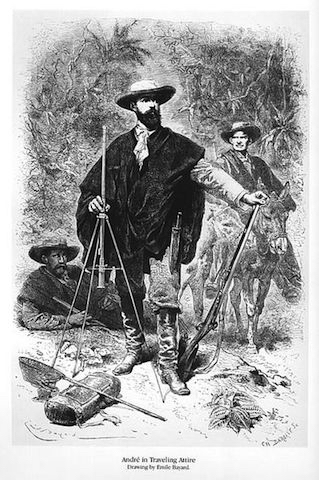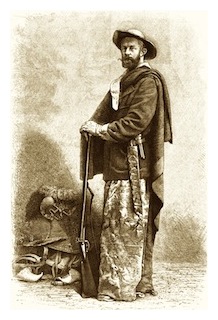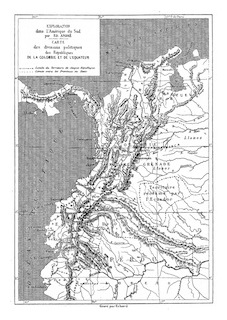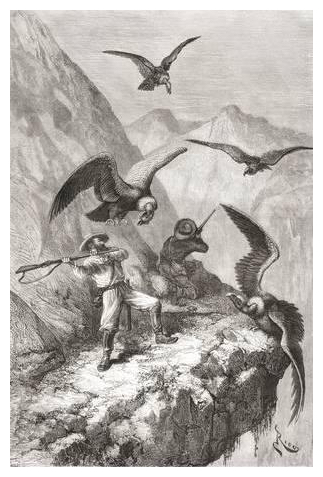Édouard André. Horticulturalist. Andean adventurer
Wednesday, March 15, 2023
Édouard André (1840-1911) was a noted French horticulturalist and one of the most prominent and celebrated European landscape designers of the second half of the 19th Century. Born in Bourges into a modest family of nurserymen, he received his early training and invaluable gardening experience at his father’s side.
André was quite the prodigy, it seems. By 1860, at the age of only twenty, he was in Paris where he worked with such luminaries of the Second Empire as Adolphe Alphand (1817-1891), Jean-Pierre Barillet-Deschamps (1824-1873) and Baron Georges Hausmann (1819-1891) on the grand redesign of the city’s boulevards and parks which still defines the French capital's look and feel today.
Among the many projects were the design and plantings of such quintessential Parisian spaces such as the Parc des Buttes-Chaumont and the Tuileries Gardens. Eventually he was Jardinier principal in the Service des Promenades et Plantations de la Ville de Paris, a position he held for eight years. Other projects in France included the Champ de Mars in Montpellier, the Public Garden in Cognac, and the world’s largest rose garden at L’Haÿ-les-Roses.
In 1866 André won the competition to design Sefton Park for the City of Liverpool in England. This was to be his first great international commission and launched an illustrious career that stretched across Europe. Over the course of his life, André would design many prominent public and private landscape parks such as the Euxinograd Royal Palace in Bulgaria, Luxemburg Castle in Luxemburg, Funchal on Madeira, Weldham Castle in Markelo in the Netherlands and the Villa Borghese gardens in Rome, among many others. For the Polish-Lithuanian Count Feliks Tyszkiewicz, André designed no less than four separate gardens at four palaces in Lithuania. What is now the Palanga Botanical Park, at the Tyszkiewicz Palace on the Baltic Coast, is still considered one of the most beautiful parks in that country.

In 1875-76, André undertook a botanizing and collecting trip through Andean foothills to explore northern South America at the behest of the French government. He journeyed south from Colombia, through Ecuador, and into Peru. Along with many scientific specimens, including a new Fuchsia that was to be described in his honor, the trip produced numerous hardy and tender plants that were new to European cultivation. An account of his adventures in the Andes, complete with such melodramatic woodcuts as André and his party fighting off attacking condors on the harrowing cliffs of a treacherous mountain pass, would be published in Le Tour du Monde as “L’Amérique Équinoxiale (Colombie – Équateur – Pérou)” in 1877. The dangers facing the intrepid horticulturalist were probably a bit enhanced for the telling. Unfortunately for André, while the French government asked him to go the trip, they didn't actually pay for him to go; he recouped his expenses by selling his collections to the Royal Botanical Garden at Kew.

André was accompanied on part of the exploratory adventure by Fritz de Scherff (1847-1896), a well-connected younger nobleman from Luxemburg. The twenty-eight year old de Scherff had decided to tag along with his friend not as a botanist or naturalist but simply as a tourist and traveling companion. The natural rigors of the expedition were apparently not to de Scherff’s expectations and he amicably parted company from André and the group with a warm handshake, as André reports, to return to Quito. De Scherff would not be seen again by André until eighteen months later in André's salon in Paris. Nonetheless, André did still describe Fuchsia scherffiana in his honor in 1888. Though perhaps not without more than a passing nod to Fritz’s father, the very important Luxemburg politician and minister, Paul de Scherff. The original collection of this relatively rare species was likely made for André in southern Ecuador.
A number of André's many plant specimens were actually collected for him by other plant hunters on commission. It was the Belgian Hugo Poortman (1858-1953), for example, who seems to have found the relatively rare F. scherffiana, much further south in the Loja and Zamora-Chinchipe Provinces of Ecuador than André himself travelled, a couple of months after he returned to Europe in September 1876. However, this doesn't seem to be the case with another of André's collections, Fuchsia vulcanica, as he passed directly through the Chimborazo province, home of the mighty Chimborazo volcano, to which it's native. André himself, of course, is memorialized in Fuchsia andrei which he collected as well.
Especially interested in bromeliads, André would published those collections of this family as Bromeliaceae Andreanae. Description et Histoire des Bromeliacées récoltées dans la Colombie, l'Ecuador et la Venezuela.
(Illustrations: 1. Portrait of Édouard André, ca.1880; 2. André's plan of Sefton Park, Liverpool, 1866; 3. André in Traveling Attire, Émile Bayard, about 1880; 4. Exploration dans l'Amérique du Sud par Édouard André, Carte des divisions politique de républiques de la Colombie et de l'Équateur. Édouard André, “L’Amérique Équinoxiale (Colombie – Équateur – Pérou),” Le Tour du Monde, 1877; 5. Portrait of Fritz de Scherff posed as an explorer in exotic costume. Engraving by E. Ronjat in Charton, Édouard. Le tour du monde - nouveau journal des voyages - livraisons n°1169,1170,1171,1172 et 1173 - L'Amérique équinoxiale par Ed. André, voyageur chargé d'une mission du gouvernement français (1875-1876.)
The Fuchsia+Blog Tags — botanists | horticulture | history | species





